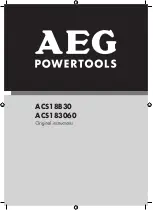
8
EN
from moving parts.
Loose clothes, jewellery or long hair
can be caught in moving parts.
g) If devices are provided for the connection of dust
extraction and collection facilities, ensure these are
connected and properly used.
Use of dust collection
can reduce dust-related hazards.
h) Do not let familiarity gained from frequent use of
tools allow you to become complacent and ignore
tool safety principles.
A careless action can cause
severe injury within a fraction of a second.
4) Power tool use and care
a) Do not force the power tool. Use the correct power
tool for your application.
The correct power tool will
do the job better and safer at the rate for which it was
designed.
b) Do not use the power tool if the switch does not turn
it on and off.
Any power tool that cannot be controlled
with the switch is dangerous and must be repaired.
c) Disconnect the plug from the power source and/or
the battery pack from the power tool before making
any adjustments, changing accessories, or storing
power tools.
Such preventive safety measures reduce
the risk of starting the power tool accidentally.
d) Store idle power tools out of the reach of children
and do not allow persons unfamiliar with the power
tool or these instructions to operate the power tool.
Power tools are dangerous in the hands of untrained
users.
e) Maintain power tools. Check for misalignment or
binding of moving parts, breakage of parts and any
other condition that may affect the power tool’s
operation. If damaged, have the power tool repaired
before use.
Many accidents are caused by poorly
maintained power tools.
f) Keep cutting tools sharp and clean.
Properly
maintained cutting tools with sharp cutting edges are
less likely to bind and are easier to control.
g) Use the power tool, accessories, tool bits, etc., in
accordance with these instructions, taking into
account the working conditions and the work to be
performed.
Use of the power tool for operations different
from those intended could result in a hazardous situation.
h) Keep handles and grasping surfaces dry, clean
and free from oil and grease.
Slippery handles and
grasping surfaces do not allow for safe handling and
control of the tool in unexpected situations.
5) Battery tool use and care
a) Recharge only with the charger specified by the
manufacturer.
A charger that is suitable for one type
of battery pack may create a risk of fire when used with
another battery pack.
b) Use power tools only with specifically designated
battery packs.
Use of any other battery packs may
create a risk of injury and fire.
c) When battery pack is not in use, keep it away from
other metal objects, like paper clips, coins, keys,
nails, screws or other small metal objects, that can
make a connection from one terminal to another.
Shorting the battery terminals together may cause burns
or a fire.
d) Under abusive conditions, liquid may be ejected
from the battery; avoid contact. If contact
accidentally occurs, flush with water. If liquid
contacts eyes, additionally seek medical help.
Liquid
ejected from the battery may cause irritation or burns.
e) Do not use a battery pack or tool that is damaged or
modified.
Damaged or modified batteries may exhibit
unpredictable behaviour resulting in fire, explosion or risk
of injury.
f) Do not expose a battery pack or tool to fire or
excessive temperature.
Exposure to fire or temperature
above 265 °F may cause explosion.
g) Follow all charging instructions and do not charge
the battery pack or tool outside the temperature
range specified in the instructions.
Charging
improperly or at temperatures outside the specified range
may damage the battery and increase the risk of fire.
6) Service
a) Have your power tool serviced by a qualified repair
person using only identical replacement parts.
This will ensure that the safety of the power tool is
maintained.
b) Never service damaged battery packs.
Service
of battery packs should only be performed by the
manufacturer or authorized service providers.
GENERAL CHAIN SAW SAFETY WARNINGS:
a) Keep all parts of the body away from the saw chain
when the chain saw is operating. Before you start
the chain saw, make sure the saw chain is not
contacting anything.
A moment of inattention while
operating chain saws may cause entanglement of your
clothing or body with the saw chain.
b) Always hold the chain saw with your right hand
on the rear handle and your left hand on the front
handle.
Holding the chain saw with a reversed hand
configuration increases the risk of personal injury and
should never be done.
c) Hold the chain saw by insulated gripping surfaces
only, because the saw chain may contact hidden
Summary of Contents for CCS36WT
Page 1: ...Cordless chainsaw EN WS8303U CCS36WT 2...
Page 2: ......
Page 3: ...1 2 3 4 5 6 7 8 9 10 11 1314 12 15 16 17 18...
Page 4: ...1 2 kink Fig A1 Fig A2 Fig A3 Fig A4 Fig A5 Fig B1 Fig B2 Fig C...
Page 5: ...Pos 1 Hand guard Pos 1 Pos 2 19 Fig D Fig E Fig F Fig G Fig I Fig H 2 1 a Fig J...
Page 6: ...a Injecting grease to lubricate Fig K Fig L Fig M Fig N...
Page 20: ......






































